西安电子科技大学:《博弈论》课程教学资源(PPT课件)Lecture 5 Dynamic game with Incomplete Information
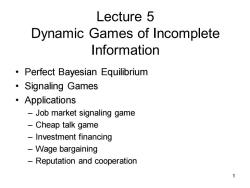
Lecture 5 Dynamic Games of Incomplete Information Perfect Bayesian Equilibrium ·Signaling Games ·Applications Job market signaling game Cheap talk game Investment financing Wage bargaining Reputation and cooperation 1
Lecture 5 Dynamic Games of Incomplete Information • Perfect Bayesian Equilibrium • Signaling Games • Applications – Job market signaling game – Cheap talk game – Investment financing – Wage bargaining – Reputation and cooperation 1

Dynamic Games of Incomplete Information Example Player 2 R C R' 3 L 21 0,0 Player 1 M 02 0,1 0 0 R 1,3 13 0 2 人 Nash equilibrium (L,L'),(R,R) Subgame perfect Nash equilibrium:(L,L'),(R,R)(no subgame) Perfect Bayesian equilibrium:(L,L')and player 2's belief:player 1 play L probability =1 (Whatever the belief,player 2 will play L') 2
Dynamic Games of Incomplete Information : Example 2 2 2 1 0 0 0 2 0 1 L M L’ R’ L’ R’ 1 1 3 R 2,1 0,0 0,2 0,1 1,3 1,3 L M R L’ R’ Player 1 Player 2 Nash equilibrium : (L,L’), (R,R’) Subgame perfect Nash equilibrium : (L,L’), (R,R’) (no subgame) Perfect Bayesian equilibrium: (L,L’) and player 2’s belief: player 1 play L probability =1 (Whatever the belief, player 2 will play L’ ) 2
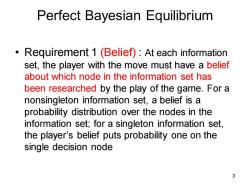
Perfect Bayesian Equilibrium Requirement 1 (Belief):At each information set,the player with the move must have a belief about which node in the information set has been researched by the play of the game.For a nonsingleton information set,a belief is a probability distribution over the nodes in the information set;for a singleton information set, the player's belief puts probability one on the single decision node 3
Perfect Bayesian Equilibrium • Requirement 1 (Belief) : At each information set, the player with the move must have a belief about which node in the information set has been researched by the play of the game. For a nonsingleton information set, a belief is a probability distribution over the nodes in the information set; for a singleton information set, the player’s belief puts probability one on the single decision node 3
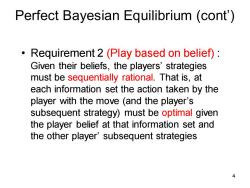
Perfect Bayesian Equilibrium(cont) Requirement 2(Play based on belief): Given their beliefs,the players'strategies must be sequentially rational.That is,at each information set the action taken by the player with the move (and the player's subsequent strategy)must be optimal given the player belief at that information set and the other player'subsequent strategies 4
Perfect Bayesian Equilibrium (cont’) • Requirement 2 (Play based on belief) : Given their beliefs, the players’ strategies must be sequentially rational. That is, at each information set the action taken by the player with the move (and the player’s subsequent strategy) must be optimal given the player belief at that information set and the other player’ subsequent strategies 4

Perfect Bayesian Equilibrium (cont) Definition:For a given equilibrium in a given extensive-form game,an information set is on the equilibrium if it will be reached with positive probability if the game is played according to the equilibrium strategies.And is off the equilibrium if it is certain not to be reached if the game is played according to the equilibrium strategies 5
Perfect Bayesian Equilibrium (cont’) • Definition: For a given equilibrium in a given extensive-form game, an information set is on the equilibrium if it will be reached with positive probability if the game is played according to the equilibrium strategies. And is off the equilibrium if it is certain not to be reached if the game is played according to the equilibrium strategies 5
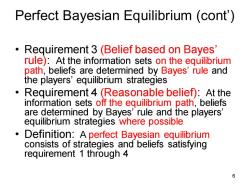
Perfect Bayesian Equilibrium(cont') Requirement 3(Belief based on Bayes rule):At the information sets on the equilibrium path,beliefs are determined by Bayes'rule and the players'equilibrium strategies Requirement 4(Reasonable belief):At the information sets off the equilibrium path,beliefs are determined by Bayes'rule and the players equilibrium strategies where possible Definition:A perfect Bayesian equilibrium consists of strategies and beliefs satisfying requirement 1 through 4 6
Perfect Bayesian Equilibrium (cont’) • Requirement 3 (Belief based on Bayes’ rule): At the information sets on the equilibrium path, beliefs are determined by Bayes’ rule and the players’ equilibrium strategies • Requirement 4 (Reasonable belief): At the information sets off the equilibrium path, beliefs are determined by Bayes’ rule and the players’ equilibrium strategies where possible • Definition: A perfect Bayesian equilibrium consists of strategies and beliefs satisfying requirement 1 through 4 6

PBE:Example 1 R 1 M 3 2 1-p R 0 0 0 0 2 1 If the play of the game reaches player 2's nonsigleton information Given player 2's belief, the expected payoff from playing R'is UR=p.0+(1-p).1=1-p the expected payoff from playing L'is UL'=p.1+(1-p).2=2-p UR<UL:for all p Subgame perfect Nash equilibrium:(L,L')p=1 Subgame perfect Nash equilibrium:(R,R)are ruled out 7
PBE: Example 1 2 2 2 1 0 0 0 2 0 1 L M L’ R’ L’ R’ 1 1 3 R Subgame perfect Nash equilibrium : (L,L’) [p] [1-p] p=1 If the play of the game reaches player 2’s nonsigleton information Given player 2’s belief, the expected payoff from playing R’ is UR’ =p.0+(1-p).1=1-p the expected payoff from playing L’ is UL ’=p.1+(1-p).2=2-p UR’ < UL’ for all p Subgame perfect Nash equilibrium : (R,R’) are ruled out 7
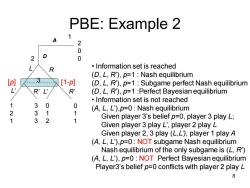
PBE:Example 2 1 2 0 2 D 0 L R Information set is reached (D,L,R'),p=1 Nash equilibrium [p] [1-p] (D,L,R'),p=1 Subgame perfect Nash equilibrium R (D,L,R),p=1 Perfect Bayesian equilibrium Information set is not reached 3 0 0 (A,L,L'),p=0:Nash equilibrium 2 3 1 3 2 1 Given player 3's belief p=0,player 3 play L; Given player 3 play L',player 2 play L Given player 2,3 play(L,L),player 1 play A (A,L,L'),p=0:NOT subgame Nash equilibrium Nash equilibrium of the only subgame is(L,R) (A,L,L'),p=0:NOT Perfect Bayesian equilibrium Player3's belief p=0 conflicts with player 2 play L 8
PBE: Example 2 3 1 2 1 3 3 3 0 1 2 0 1 1 L R L’ R’ L’ R’ 2 D [p] [1-p] A 1 2 0 0 • Information set is reached (D, L, R’), p=1 : Nash equilibrium (D, L, R’), p=1 : Subgame perfect Nash equilibrium (D, L, R’), p=1 :Perfect Bayesian equilibrium • Information set is not reached (A, L, L’),p=0 : Nash equilibrium Given player 3’s belief p=0, player 3 play L; Given player 3 play L’, player 2 play L Given player 2, 3 play (L,L’), player 1 play A (A, L, L’),p=0 : NOT subgame Nash equilibrium Nash equilibrium of the only subgame is (L, R’) (A, L, L’), p=0 : NOT Perfect Bayesian equilibrium Player3’s belief p=0 conflicts with player 2 play L 8
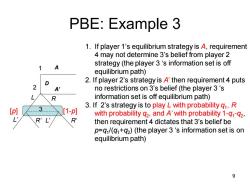
PBE:Example 3 1.If player 1's equilibrium strategy is A,requirement 4 may not determine 3's belief from player 2 strategy(the player 3's information set is off equilibrium path) D 2.If player 2's strategy is A'then requirement 4 puts 2 no restrictions on 3's belief(the player 3's R information set is off equilibrium path) 3.If 2's strategy is to play L with probability q,R [p] [1-p] with probability q2,and A'with probability 1-q-q2, R then requirement 4 dictates that 3's belief be p=q/(q+q2)(the player 3's information set is on equilibrium path) 9
PBE: Example 3 3 L R L’ R’ L’ R’ 2 D [p] [1-p] 1 A A’ 1. If player 1’s equilibrium strategy is A, requirement 4 may not determine 3’s belief from player 2 strategy (the player 3 ‘s information set is off equilibrium path) 2. If player 2’s strategy is A’ then requirement 4 puts no restrictions on 3’s belief (the player 3 ‘s information set is off equilibrium path) 3. If 2’s strategy is to play L with probability q1 , R with probability q2 , and A’ with probability 1-q1 -q2 , then requirement 4 dictates that 3’s belief be p=q1 /(q1+q2 ) (the player 3 ‘s information set is on equilibrium path) 9
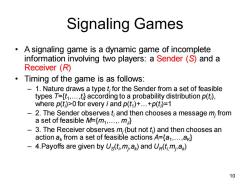
Signaling Games A signaling game is a dynamic game of incomplete information involving two players:a Sender (S)and a Receiver (R) 。 Timing of the game is as follows: -1.Nature draws a type f;for the Sender from a set of feasible types T={f,...,t according to a probability distribution p(t), where p(t)>0 for every i and p(f)+...+p(t)=1 -2.The Sender observes t;and then chooses a message m;from a set of feasible M=tm,...,.m 3.The Receiver observes m;(but not t)and then chooses an action ak from a set of feasible actions A={a,...,a -4.Payoffs are given by Us(ti,miak)and UR(ti.mj,ak) 10
Signaling Games • A signaling game is a dynamic game of incomplete information involving two players: a Sender (S) and a Receiver (R) • Timing of the game is as follows: – 1. Nature draws a type t i for the Sender from a set of feasible types T={t1 ,…,t I } according to a probability distribution p(t i ), where p(t i )>0 for every i and p(t1 )+…+p(t I )=1 – 2. The Sender observes t i and then chooses a message mj from a set of feasible M={m1 ,…,. mJ } – 3. The Receiver observes mj (but not t i ) and then chooses an action ak from a set of feasible actions A={a1 ,…,aK} – 4.Payoffs are given by US (t i ,mj ,ak ) and UR(t i,mj ,ak ) 10
按次数下载不扣除下载券;
注册用户24小时内重复下载只扣除一次;
顺序:VIP每日次数-->可用次数-->下载券;
- 西安电子科技大学:《博弈论》课程教学资源(PPT课件)Lecture 4 Static game of incomplete information.ppt
- 西安电子科技大学:《博弈论》课程教学资源(PPT课件)Lecture 3 Dynamic games of complete information.ppt
- 西安电子科技大学:《博弈论》课程教学资源(PPT课件)Lecture 2 Mixed strategy game(任课教师:栾浩).ppt
- 西安电子科技大学:《博弈论》课程教学资源(PPT课件)Lecture 1 GAME THEORY - Static complete information pure strategy game.ppt
- 《概率论与数理统计》课程教学资源(参考教材)概率论教材 Probability and Statistics《A FIRST COURSE IN PROBABILITY》英文电子版(Eighth Edition,Sheldon Ross).pdf
- 同济大学:《概率论与数理统计》课程教学资源(讲稿)Chapter 9 Sampling Distributions.pdf
- 同济大学:《概率论与数理统计》课程教学资源(讲稿)Chapter 10 Point Estimation.pdf
- 同济大学:《概率论与数理统计》课程教学资源(讲稿)Chapter 8 Limit Theorems.pdf
- 同济大学:《概率论与数理统计》课程教学资源(讲稿)Chapter 6 Jointly Distributed Random Variables.pdf
- 同济大学:《概率论与数理统计》课程教学资源(讲稿)Chapter 5 Continuous Random Variables.pdf
- 同济大学:《概率论与数理统计》课程教学资源(讲稿)Chapter 4 Mathematics.pdf
- 同济大学:《概率论与数理统计》课程教学资源(讲稿)Chapter 3 Conditional Probability and Independence.pdf
- 同济大学:《概率论与数理统计》课程教学资源(讲稿)Chapter 2 Axioms of Probability(负责人:花虹).pdf
- 同济大学:《复变函数和积分变换》课程教学资源(PPT课件讲稿)习题选讲4(积分的计算、共形映照).pptx
- 同济大学:《复变函数和积分变换》课程教学资源(PPT课件讲稿)习题选讲3(级数及其应用、奇点与留数).pptx
- 同济大学:《复变函数和积分变换》课程教学资源(PPT课件讲稿)习题选讲2(复变函数的两种形式、计算解析函数的级数).pptx
- 同济大学:《复变函数和积分变换》课程教学资源(PPT课件讲稿)习题选讲1(复数的四则运算、复数的幂与根).pptx
- 同济大学:《复变函数和积分变换》课程教学资源(PPT课件讲稿)5-2-分式线性变换.pptx
- 同济大学:《复变函数和积分变换》课程教学资源(PPT课件讲稿)5-1-映射的共形性.pptx
- 同济大学:《复变函数和积分变换》课程教学资源(PPT课件讲稿)4-3-利用积分变换求解微分方程.pptx
- 同济大学:《常微分方程》课程教学资源(讲义)First-order differential equations.pdf
- 同济大学:《常微分方程》课程教学资源(讲义)微分方程基本概念及几类可求解析解的方程.pdf
- 同济大学:《常微分方程》课程教学资源(讲义)高阶线性微分方程.pdf
- 同济大学:《常微分方程》课程教学资源(讲义)线性微分方程组 Linear Systems of Differential Equations(负责人:尚培培).pdf
- 同济大学:《常微分方程》课程教学资源(讲义)非线性微分方程及现象 Nonlinear Systems and Phenomena.pdf
- 同济大学:《运筹学》课程教学资源(试卷习题)运筹学试卷1.doc
- 同济大学:《运筹学》课程教学资源(试卷习题)运筹学试卷2.doc
- 同济大学:《运筹学》课程教学资源(课件讲稿)引言 Operations Research(负责人:陈雄达).pdf
- 同济大学:《运筹学》课程教学资源(PPT课件讲稿)线性规划基本性质.ppt
- 同济大学:《运筹学》课程教学资源(PPT课件讲稿)一维搜索.ppt
- 同济大学:《运筹学》课程教学资源(PPT课件讲稿)单纯形方法.ppt
- 同济大学:《运筹学》课程教学资源(PPT课件讲稿)对偶理论及灵敏度分析.ppt
- 同济大学:《运筹学》课程教学资源(PPT课件讲稿)整数(线性)规划.ppt
- 同济大学:《运筹学》课程教学资源(PPT课件讲稿)使用导数的最优化方法(无约束优化方法).ppt
- 同济大学:《运筹学》课程教学资源(PPT课件讲稿)最优性条件.ppt
- 同济大学:《运筹学》课程教学资源(PPT课件讲稿)惩罚函数法.ppt
- 《线性代数》课程教学资源(文献资料)THE $25,000,000,000 EIGENVECTOR THE LINEAR ALGEBRA BEHIND GOOGLE.pdf
- 《线性代数》课程教学资源(文献资料)数据降维方法综述(清华大学:马小龙).pdf
- 《线性代数》课程教学资源(文献资料)主元分析(PCA)理论分析及应用.pdf
- 同济大学:《线性代数》课程教学资源(试卷习题)2006-2007学年第二学期B卷(含答案).pdf
